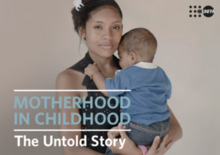This report examines trends in adolescent childbearing using techniques that focus on the most vulnerable girls, such as child mothers, girls with repeat adolescent childbearing, and births that occur in dangerously quick succession. In using these new measures, it uncovers the untold story of more than 50 years of adolescent childbearing in the world’s low- and middle-income countries. The new measures reveal that the issue is not just about whether or not a girl gives birth in adolescence but if, when and how many births she experiences. That is, adolescent childbearing comprises three fundamental and interconnected fertility processes: (i) the timing of a first adolescent birth, (ii) the spacing between adolescent births and (iii) the quantity or total number of births to each adolescent mother.
This multifaceted process is most immediately shaped by factors such as the age of menarche and sexual debut, the frequency of sexual activity, the patterns of marriage and union formation, and the use and effectiveness of contraception. It is worth emphasizing that the majority of first births to girls aged 17 years and younger, in 54 developing countries with data, occur within marriage or cohabiting unions. More distal determinants – such as girls’ education – are also critical to the process and include gendered social, economic, cognitive and psychological factors at the individual, peer, family and community levels. Additionally, broader norms, values, inequalities, events, economic forces, and national laws, policies and priorities shape the adolescent fertility landscape. It is important to note that this analysis examines births, not pregnancies, which are also critically important and treated in other publications. The trends in pregnancies can tell a very different story given differences in access to and the use of abortion across the globe. Each year, adolescent girls aged 15 to 19 years in low- and middle-income countries have an estimated 21 million pregnancies, nearly half of which – 10 million – are unintended. More than a quarter of those 21 million – an estimated 5.7 million – end in abortion, the majority of which occur in unsafe conditions.
Across the globe, there are encouraging signs of declining levels of motherhood in childhood (17 years and younger) and in adolescence (19 years and younger). Nevertheless, in many ways, the pace of decline has been alarmingly slow – often declining by only a fe w percentage points per decade – and has not kept pace with declines in total fertility. Key findings from this technical report on the most recent trends across low- and middle-income countries are shown in the Key Findings table to the right. With a fuller understanding of the timing, spacing and quantity of the adolescent childbearing process – and eventually their proximate and distal determinants – policy and programming can better frame and target their approaches. Promising interventions include components of asset building for adolescent girls, support for families and parents, comprehensive sexuality education, health service provision, and community and policy engagement. This report’s findings on the prevalence of motherhood in childhood and repeat adolescent childbearing highlight that more needs to be done to design, implement and evaluate programmes that target the youngest starters and girls at risk of rapid and repeat adolescent births.

